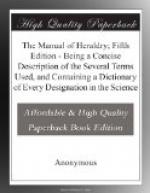MORION. A steel cap or helmet formerly worn by foot soldiers below the rank of gentlemen.
MOTTO. A word or short sentence inserted in a scroll, which is generally placed beneath the escutcheon; in some instances it is placed above the crest. The motto frequently alludes to the name of the bearer of the arms, as the motto of the Right Honourable Lord Fortescue—FORTE SCUTUM SALUS DUCUM, a strong shield is the safety of commanders. Sometimes the motto is the watchword or war-cry in the battle where the original bearer won the honours that are retained by his descendants. Generally the motto is founded upon the piety, loyalty, valour, fortitude, &c. of the persons to whom arms were granted.
[Illustration: MOUND.]
MOUND. A globe encircled with a band and surmounted with a cross; it is an ensign of royalty, signifying dominion.
MULLET. From the French word molette, the rowel of a spur: it is generally drawn with five points, as in the annexed example: when more points are used they are named.
[Illustration: Mullet]
EX. Azure, a mullet or.
MURAILE. A French term for walled.
MURREY. A word used by ancient armorists instead of sanguine.
NAIANT. A French term for swimming. This term is used in Heraldry when a fish is drawn in an horizontal position.
[Illustration: Naiant]
EX. Argent, a salmon proper, naiant, its head towards the sinister side of the shield.
NAISSANT. A French word signifying coming out. It is used when a lion or any other animal appears to be rising out of the centre of an ordinary.
[Illustration: Naissant]
EX. Or, from the midst of a fess, gules, a lion rampant naissant.
NEBULE, or NEBULY. A French word, signifying cloudy, represented by a curved line, thus—
[Illustration: NEBULE, or NEBULY.]
NOBILITY. Under this denomination are comprehended—dukes, marquises, earls, viscounts, and barons only. Archbishops and bishops are included in the rank of clergy.
NOMBRIL POINT. That part of the shield below the fess point. See page 6. letter F. [CHAP. II.]
NORROY. The name of one of the Kings-at-Arms. See King-at-Arms.
NOWED. This word signifies tied or knotted, and is applied to serpents, wiverns, or any animals whose tails are twisted and enfolded like a knot.
[Illustration: EX. Argent, a serpent nowed proper.]
OGRESSES. Black roundlets.
OR. The French word for gold. This tincture is denoted in engraving by small points.
[Illustration: EX. Or, a bend gules.]
ORANGES. Roundlets tinctured tenne.
ORDINARY. A term used to denote the simple forms which were first used as heraldic distinctions, and therefore called honourable ordinaries, as conferring more honour than later inventions. They are the chief, pale, bend, bend sinister, fess, bar, chevron, cross, and cross saltier. There are thirteen subordinate ordinaries. The form, size, and place that the honourable and subordinate ordinaries occupy in an achievement are all described in the Manual, and in this Dictionary under their different names.




